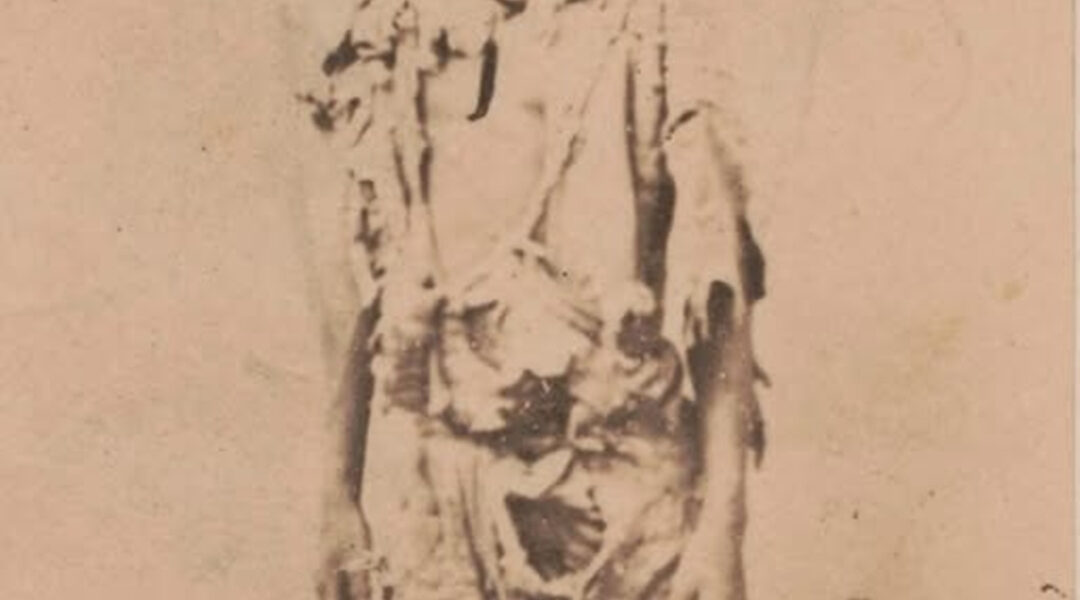The photograph is haunting. A boy, barely more than a child, stands in tattered rags that hang loosely from his thin body. His eyes—solemn, unblinking—stare directly into the lens, as though daring history not to forget him. His name was Taylor, a drummer boy for the 78th Colored Troops Infantry during the Civil War.
The war did not ask his age. It did not wait for him to grow into manhood before pressing him into its terrible work. It simply swallowed him whole, as it did so many others.

The Making of a Drummer Boy
Taylor had known hardship long before he marched with soldiers. Like so many children of his generation—especially those born into bondage or its shadow—his childhood was cut short. He had no toys, no schoolbooks, no childhood in the way we imagine it. What he had was survival, and survival meant learning to work, to obey, and to endure.
But he also had rhythm. Somewhere along the way—perhaps at a church service, perhaps with sticks beating against a wooden fence—he discovered that rhythm gave life order. It gave the heart something to follow. When the recruiters came, when the 78th Colored Troops gathered men to march for the Union and for freedom, Taylor was too young to carry a rifle. But he was old enough to carry a drum.
The drum was more than an instrument. It was the voice of the regiment. Soldiers rose to its beat in the morning, drilled by its cadence in the afternoon, and marched in step to its rhythm into battle. For the men of the 78th, who had once been denied even the right to carry a gun, that beat meant unity, pride, and power. And it was Taylor—thin, ragged, barefoot sometimes—who kept that beat alive.
The Hard March
The men of the 78th Colored Troops knew they were fighting two battles: one against the Confederacy, and one against the prejudice of the very country they served. Union officers often doubted their courage, sneered at their presence, or treated them as expendable. Confederate soldiers hated them with a deeper rage, for their very existence as armed Black men was a living defiance.
Taylor absorbed it all. He saw the looks, heard the slurs, and felt the sting of being underestimated. But when his sticks struck his drum, all of that fell away. He was not just a boy then. He was the heartbeat of the regiment.
Mud clung to their boots. Hunger gnawed at their bellies. Gunfire split the night sky. Yet through it all, Taylor’s drumbeat carried them forward. Each tap said: We are here. We are still marching. We are not broken.
The Fire of Battle
One morning, before dawn, the 78th prepared for a skirmish. The men whispered quiet prayers, adjusted their belts, and tightened their grips on their rifles. Taylor sat to the side, his drum beside him, staring into the fire. A sergeant noticed his silence and asked, “You scared, boy?”
Taylor looked up, his young face both fragile and determined.
“Yes, sir,” he said honestly.
The sergeant nodded. “Good. Only fools ain’t scared. Just keep that beat steady. Don’t let us forget who we are.”
When the order came, Taylor’s hands trembled, but his sticks held firm. His drum called out over the smoke and chaos, steadying the men as bullets tore through the air. He was too small to fight, too young to grasp the full horror of war, yet in that moment, he was braver than most. He gave the soldiers something to follow when fear threatened to scatter them.
The Boy in Rags
After battle, the regiment often returned bloodied, weary, and thin. Supplies were scarce. Pay was inconsistent. And for the Colored Troops, what little they had was often less than what their white counterparts received. Taylor’s clothes became ragged, torn from endless marches and patched too many times to hold.
That is how history remembers him—in rags, his dignity stripped by poverty, yet his spirit unbowed. His eyes in that old photograph tell the truth: he had given everything, and still, he stood.
Why He Stayed
Once, an officer asked him why he stayed. Why he risked his life day after day when he was so young. Taylor’s answer was simple:
“Because if I don’t beat this drum, who will know we came?”
In those words lies the essence of his sacrifice. He was not fighting for medals, nor for fame. He was fighting to be seen. To make sure his regiment—men who had once been invisible to the world—would not march unnoticed into history.
The Legacy of the 78th—and of Taylor
The 78th Colored Troops Infantry fought with valor in campaigns that history books too often summarize in a line or two. Many never returned home. Many died without graves, their names lost to time. But they fought. They bled. They proved, over and over again, that freedom was worth everything.
And in the background, always, was Taylor. His clothes in tatters, his stomach often empty, but his drumbeat strong.
When the war ended, when the guns went silent, boys like Taylor were often forgotten. They did not have memoirs. They did not have monuments. What remains is a photograph, and perhaps a memory whispered down through families and communities that refused to let them disappear.
But look closely at that photograph. Look into his eyes. You will see no fear, no self-pity. You will see resolve. You will see a child who carried the weight of history on his shoulders.
A Drumbeat That Still Echoes
Today, when we speak of the Civil War, we remember generals and battles, emancipation and loss. But we must also remember Taylor—the drummer boy in rags—because his story is the story of resilience itself.
Every strike of his drum was a declaration: We matter. We fight. We are free men in the making.
He may not have lived long. He may not have had riches or fine clothes. But his courage, captured in a single photograph, still beats like a drum through the corridors of history.
Because Taylor was not just a boy in rags. He was a soldier of dignity. A child of war. And a reminder that sometimes the smallest hands carry the loudest echoes of freedom.




